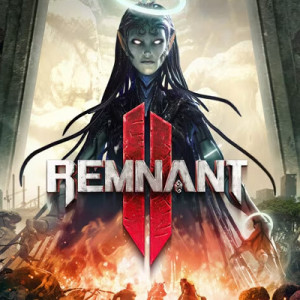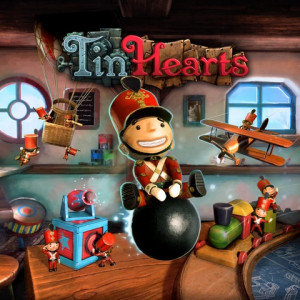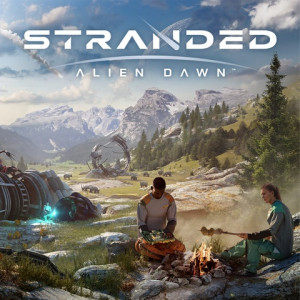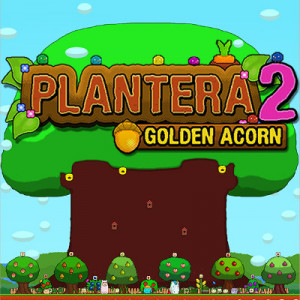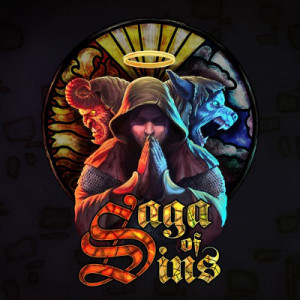One big love-letter to the JRPGs of the 90s -- But does it work?
This is a bit of a tricky one.
Okay, let's go with the pitch first. The Tenth Line is an indie RPG very deeply inspired by JRPGs, your classic Dragon Quest and Final Fantasytype stuff. Its big twist, aside from its battle system, is that its overworld navigation is done in side-scrolling 2D, with light platforming elements. This actually works pretty solidly at its baseline; enemies actually exist on the map without random encounters, and striking them first can offer you a free opening strike. The jumping is smooth, and it rarely felt like this whole spin on navigation was getting in the way.
 The combat itself is a bit of a different spin on the usual formula, as well. Enemies are arranged in rows and columns across the right side of the battlefield, sometimes three or four deep in either direction. Various attacks can swipe across an entire column, or pierce deep into a row, letting you get to foes held in the backlines, or can just focus everything into a single strike on one troublesome enemy. It's not the first time I've ever seen anything like this...But considering the closest comparison I have is Might & Magic: Clash of Heroes, a game that seems to have literally been forgotten by the ages for all I ever hear it mentioned, it's not exactly a common mechanic. With some active time elements brought in, not unlike the Mario RPGs, the whole combat system comes together into a pretty solid experience.
The combat itself is a bit of a different spin on the usual formula, as well. Enemies are arranged in rows and columns across the right side of the battlefield, sometimes three or four deep in either direction. Various attacks can swipe across an entire column, or pierce deep into a row, letting you get to foes held in the backlines, or can just focus everything into a single strike on one troublesome enemy. It's not the first time I've ever seen anything like this...But considering the closest comparison I have is Might & Magic: Clash of Heroes, a game that seems to have literally been forgotten by the ages for all I ever hear it mentioned, it's not exactly a common mechanic. With some active time elements brought in, not unlike the Mario RPGs, the whole combat system comes together into a pretty solid experience.
And the story, while hewing close to the typical beats, is well executed. You've got a Princess hunted by a deadly cult, animal folk facing your classic underclass situation, a couple of doom prophecies(ten Lines in total, thus the name) and a splash of political intrigue just for flavor. Just about every named character also comes with several pieces of anime-inspired custom art, and some voice acting, at least in battle and cutscenes.
Probably one of the biggest issues of taste, aside from the core issue of "are you down for what is clearly someone's love-letter to JRPGs and anime", is how the game handles progression. Because that, that gets funky. So there's two sides to progression, and...Let's just start with the shared one.
Did you ever play Final Fantasy 10? Do you remember the Sphere Grid, an interlaced network where you had to drop down Spheres to connect from your starting point to whatever stat buff it was you wanted? The Tenth Lineuses a similar mechanic...Except it throws in a twist where instead of just having generic spheres, you plug in items. And like that water-pipe-networking game that's been copied countless times, the items have different path shapes to them, and the path shapes have to line up so power can flow back in to your character at the starting point of the progression map. But interlinking like this gets you to stat buffs, as well as new moves to fill out your selection.

Then there's the other half of making the right numbers bigger. Training. Training isn't as much of an active progression system in the strictest sense, in that it's not a permanent and linear system. It's closer to character customization, in some respects; but given that you're having to push the numbers gradually to where you want them, and another side to things, this is how it's going down. That other side being...You use items.
The same items as that buff your core stats?
Yuppers.
So, okay, here's one of the places where the game gets a little bonkers. Your core three characters at the start of the game, Princess, Tox, and Rik, each have a different set of little sub-mechanics that affect their moves. The Princess wobbles between Fury and Patience with her swordplay; Rik has a quiver full of daggers that can be struck with or thrown; and Tox, being a draconic mage, has both elemental breath, and elemental affinities that affect his magic. Each of these then have a different trait they're looking for on items to enhance which aspects of their combat that they want; The Princess wants curved or rounded items to enhance her broad slashes, but sharp and pointy items to fuel her direct thrusts, for instance. While Tox wants heavy items to pour into his dark magic, light items to enhance his ethereal dodge, and elementally charged items to work his draconic powers.
And that's one of the things that makes this game kind of tricky to review. It's like I'm a sandwich reviewer, and you gave me one of those goddamned Scooby-Doo sandwiches as tall as my torso. Where should I start? Do you want my opinion on the turkey-on-rye layer? Or maybe the peanut butter and jelly layer, ten floors down on this apartment complex of a sandwich? I know, let's start at the bottom, which for some reason the talking dog has decided had to be a literal slice of pizza between two pieces of that weird bread that comes in a tin can!
That's how I feel looking at this. It's not that any of these mechanics are bad. It's not that The Tenth Line makes any major mistakes in any specific part of its existance as a game, and it's not like there's any one thing I'd say has to be taken out. It's just...It's a bit much, you know? I started writing my notes on the mechanics about an hour into the game, including cutscenes and dialogues and me just leaving the thing running when I had to answer the door. So, not very deep into it at all, is what I'm trying to get at.
In that time I had to learn a platforming system, which, okay, fair enough. A combat system, I get you. A character-swapping and puzzle-solving mechanic, alright... A new layer to the combat system. A combo mechanic. Two separate progression systems. And a collectable card game!
There's a collectable card game! Like...It's just there! I'm playing a Princess who ran away from a cult with little more than the kinda weird Alice-In-Wonderland dress they put her in before her intended sacrifice, some cash she was able to hide in her slippers, and a sword she stole during her escape...
But that 'little more' includes a deck of trading cards to play Quad Pro Quo. And, okay, listen, don't get me wrong. I'm not saying this collectable card game is, in isolate, a bad game. It's not gonna be something you decide to dedicate your life to instead of Magic: The Gathering or anything, but for what it is(an optional, unified minigame to get collectable items for those progression mechanics, as well as some extra cash) it's pretty solid.
The game is basically like if Go and the entire 90s TCG boom went and had a baby; every card has four numbers on its corners, plus an element. You lay a card down on the grid, and if it touches one of your opponent's cards, the numbers on the matching edges are checked. Whoever owns the card with the bigger numbers claims ownership of the card with the smaller numbers for the length of the game, and whoever has more cards in their color when the grid is full wins the match.
So it's not that this whole sub-game is bad. It's fun, has some solid strategy. It's just that it's, like, there. It's another layer on the Scooby-Doo sandwich, and after a while it starts to get a little absurd how many separate sets of mechanics this game has.
I mean, honestly, a lot of my complaints are kind of quibbles, or matters of taste. The sheer number of mechanics is only going to bother you if you want that tightly narrowed focus, and not everyone is.
 Some of them are even issues that almost certainly only affect me; like, my TV has a fussy issue with overscan, despite being a modern HDTV in the year 20-goddamned-17, and most games this isn't a problem. But The Tenth Line puts some UI elements alllll the way out at the very edge of its hypothetical screen space, and so on a TV like mine that cuts even a bit off, suddenly things like bottom menu options just kind of vanish into the ether. And with no in-game screen adjustment, or respect to the OS-level display-area command, there's little I can do to fix it.
Some of them are even issues that almost certainly only affect me; like, my TV has a fussy issue with overscan, despite being a modern HDTV in the year 20-goddamned-17, and most games this isn't a problem. But The Tenth Line puts some UI elements alllll the way out at the very edge of its hypothetical screen space, and so on a TV like mine that cuts even a bit off, suddenly things like bottom menu options just kind of vanish into the ether. And with no in-game screen adjustment, or respect to the OS-level display-area command, there's little I can do to fix it.
But there's a thing or two that are more universal. Quibbles still, but at least shared ones. The button prompts have a tendency to always be a circle with a symbol in them. For face button prompts, this is fine, no fuss. For things like the triggers, though, it can flub you up, especially when some of those prompts are teeny tiny.
Or how the "follow" mechanic in the platforming segments doesn't include any auto platforming, or even just hooking the other characters into the background and have them stay locked with you. So you end up mostly having to just go through each segment three times in succession, unless you want to open each fight solo and have to wait a turn or two for the others to show up; an interesting mechanic, but the resulting incentive is to just always keep everyone close-by if I can help it, and so we get back to the "do everything three times in succession" for even the simplest jump.
Yet at the end of the day...I mean, there's a good core here. The game has some rough edges, but the sheer passion courses through this thing like none of the big AAA games are going to do. The game's reach, at times, can exceed its grasp...but that's not the worst crime. And even when it stumbles, it's usually at least stumbling in a far more interesting way than the kind of games that play it far too safe in a bid to be an also-ran.
So I recommended the game up at the top. You know this. With all my rambling and ranting and weird sandwich tangents, you might be wondering why. And if I have to boil it down...It's that, right there. Passion. The game's got its flaws, some of which are technical enough that I hope get patched out, and some of which are just inherent to the design. But I really get the sense here of a game made by someone who loved the JRPGs they grew up on and wanted to make a game like that, wanted to turn their love into something they could share with others.
And when you really get down to it...I respect the hell out of The Tenth Line for that fact. And that kind of respect carries so, so much farther than the game's modest $12.99 price tag.

